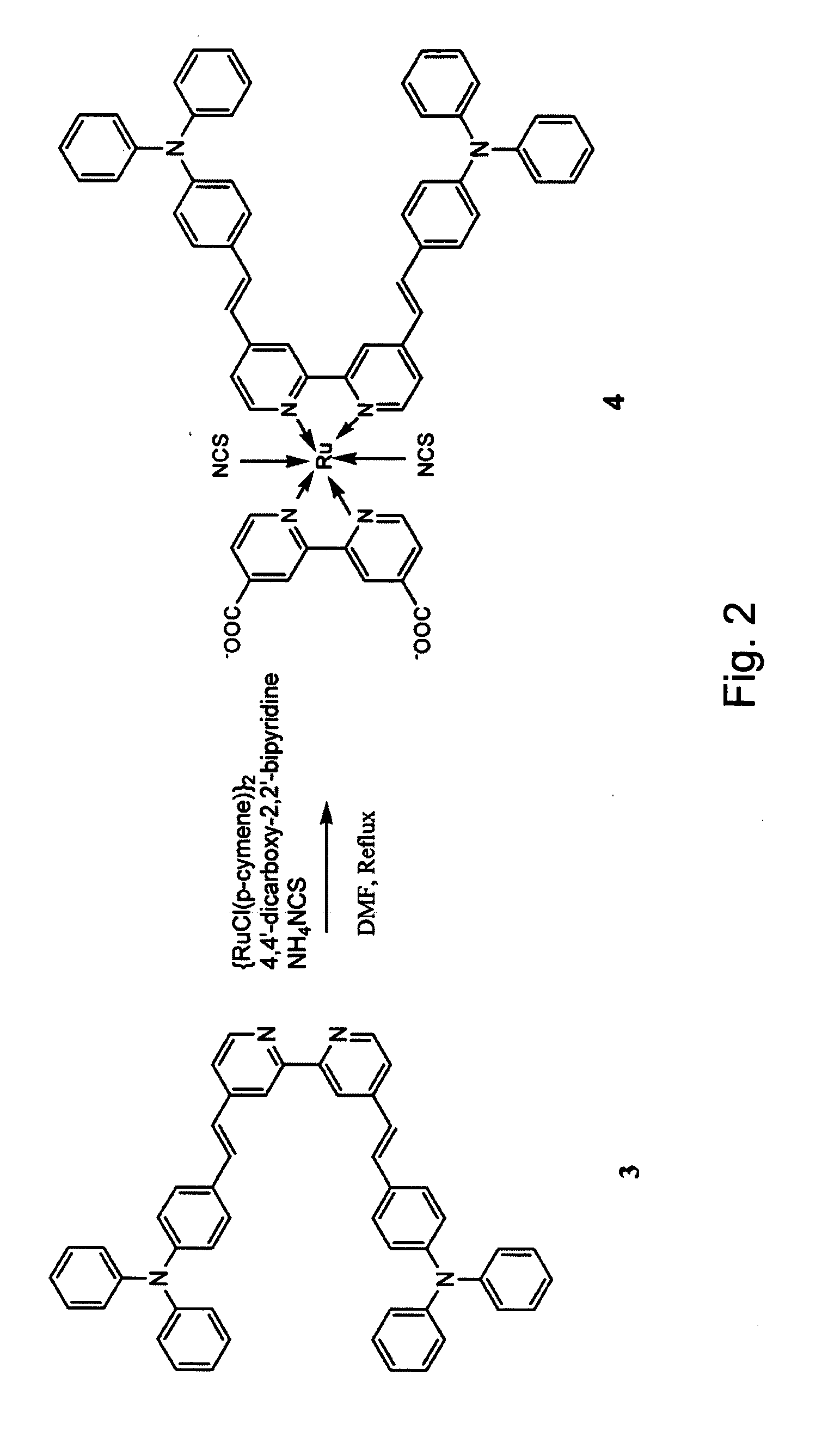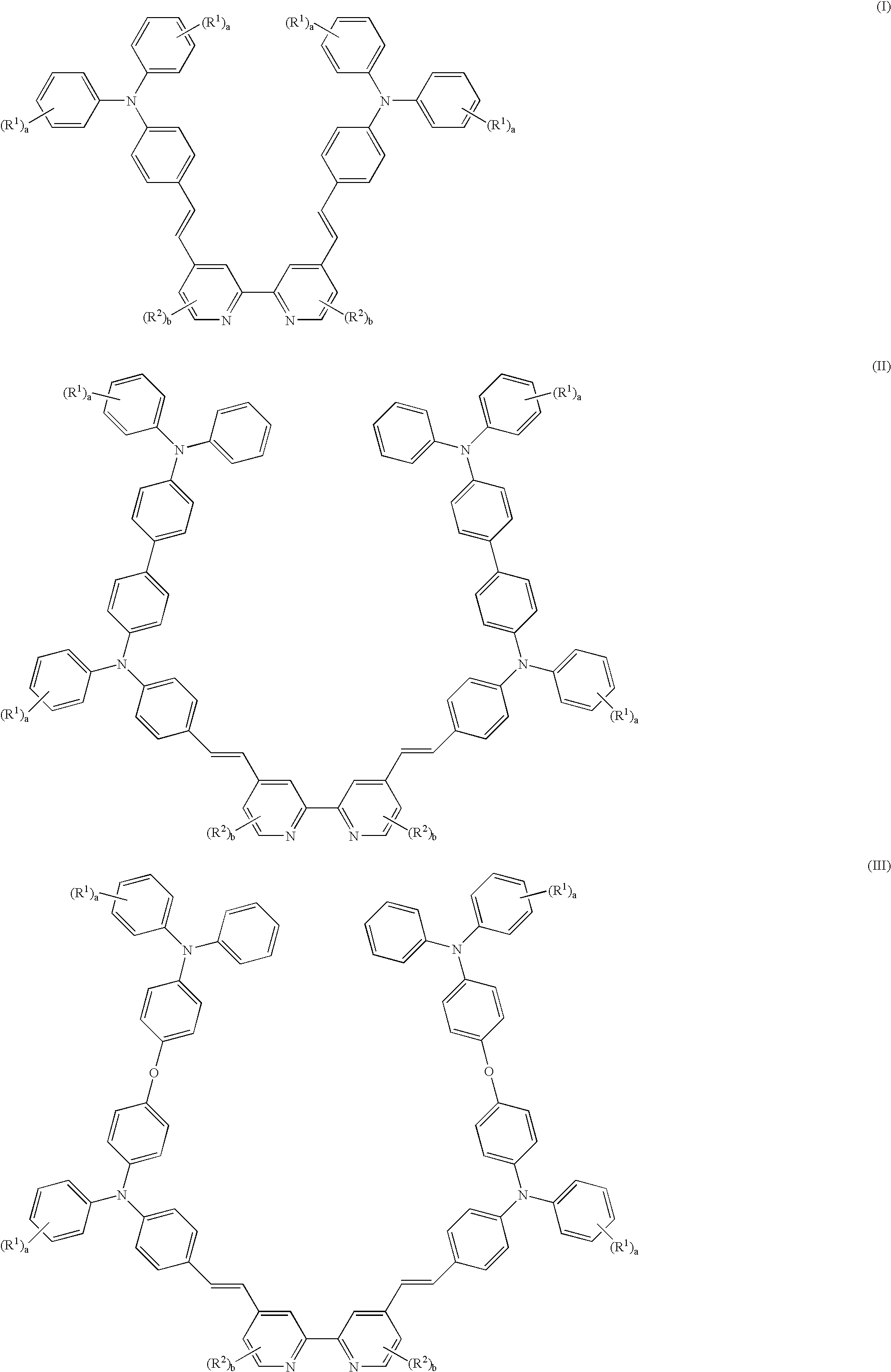Metal complex compositions and use thereof in dye sensitized solar cells
a technology of metal complex compositions and solar cells, applied in the direction of ruthenium organic compounds, electrolytic capacitors, thermoelectric devices, etc., can solve the problem of increasing the possibility of unproductive back reaction
- Summary
- Abstract
- Description
- Claims
- Application Information
AI Technical Summary
Benefits of technology
Problems solved by technology
Method used
Image
Examples
example 1
[0051] Synthesis of 4,4′-bis[4-(diphenylamino)styryl]-2,2′-bipyridine (bpy(TPA)2, 3): Under an argon atmosphere 4.5 g (5.8 mmol) of bisphosphonium salt 2 (FIG. 1) and 3.17 g (11.6 mmol) of 4-diphenylaminobenzaldehyde were dissolved in 50 ml of dry tetrahydrofuran (THF) and heated to 50° C. A suspension of 2.23 g (23.2 mmol) of NaOtBu in THF was slowly added to the stirred reaction mixture via a dropping funnel followed by stirring at 50° C. for 4 h. After cooling to room temperature the reaction mixture was neutralized with acetic acid (10%) and extracted with CH2Cl2. The combined organic fractions were washed with H2O (2×) and with an aqueous solution of NaOAc (1×). After drying over Na2SO4 and evaporation of the solvent, the residue was purified via column chromatography (cyclohexane:EtOAc=5:1) yielding ligand IX, designated structure 3 in FIG. 1, (2 g) as a yellow powder. (Yield=50%). 1H-NMR (CDCl3), δ (ppm): 6.95-7.44 (m, 17H), 8.49 (s, 1H, bpy), 8.62 (d, 1H, bpy). FT-IR (KBr), ...
example 2
[0052] Synthesis of Ru(bpyCOOH2)(bpyTPA2)(NCS)2 XXII Dichloro(p-cymene)Ru(II) dimer (0.23 g, 0.375 mmol) was charged to an argon flushed three-neck flask and dissolved in dry dimethylformamide (DMF, 35 ml). Ligand IX prepared in Example 1, bpy(TPA)2 (0.52 g, 0.75 mmol), was added, the solution was stirred at 100° C. until the starting Ru(II) compound had been fully consumed as judged by thin layer chromatography (TLC). The second ligand, 4,4′-dicarboxy-2,2′-bipyridine (0.183 g, 0.75 mmol) was then added to the above solution and the solution was stirred at 150° C. for 5 h. Subsequently, ammonium thiocyanate (NH4SCN, 1.43 g, 18.75 mmol) was added and the reaction mixture was stirred at 150° C. for an additional 4-5 hours, DMF was then vacuum-distilled from the reaction flask. The residue was dissolved in THF / methanol and a black solid precipitated after addition of diethylether. The precipitate was collected and washed with diethylether to yield the reddish-brown raw product. Repreci...
PUM
| Property | Measurement | Unit |
|---|---|---|
| wavelength | aaaaa | aaaaa |
| incident angle | aaaaa | aaaaa |
| thickness | aaaaa | aaaaa |
Abstract
Description
Claims
Application Information
 Login to View More
Login to View More - R&D
- Intellectual Property
- Life Sciences
- Materials
- Tech Scout
- Unparalleled Data Quality
- Higher Quality Content
- 60% Fewer Hallucinations
Browse by: Latest US Patents, China's latest patents, Technical Efficacy Thesaurus, Application Domain, Technology Topic, Popular Technical Reports.
© 2025 PatSnap. All rights reserved.Legal|Privacy policy|Modern Slavery Act Transparency Statement|Sitemap|About US| Contact US: help@patsnap.com



